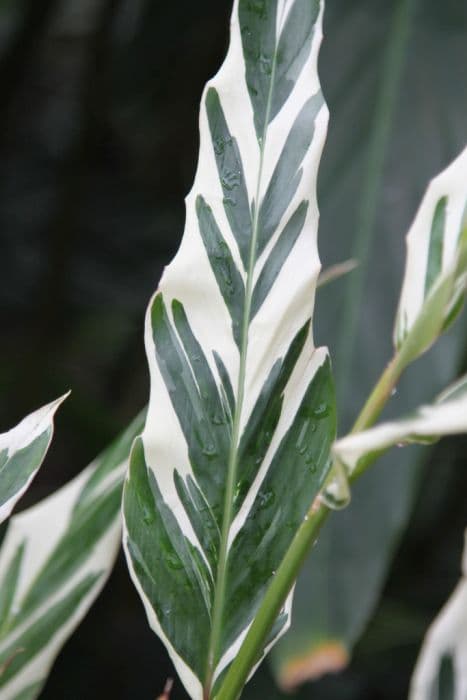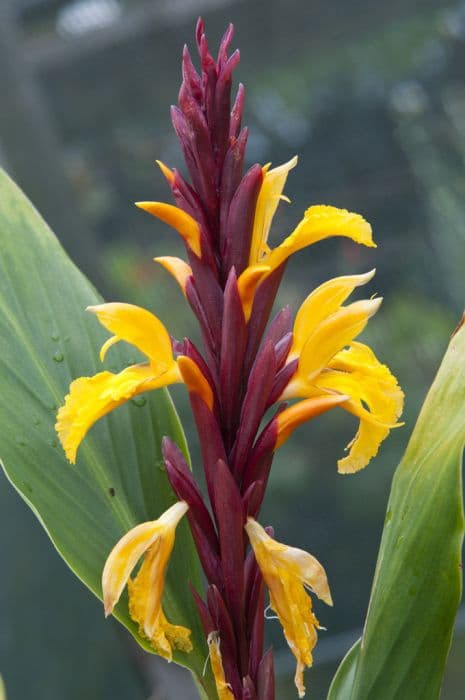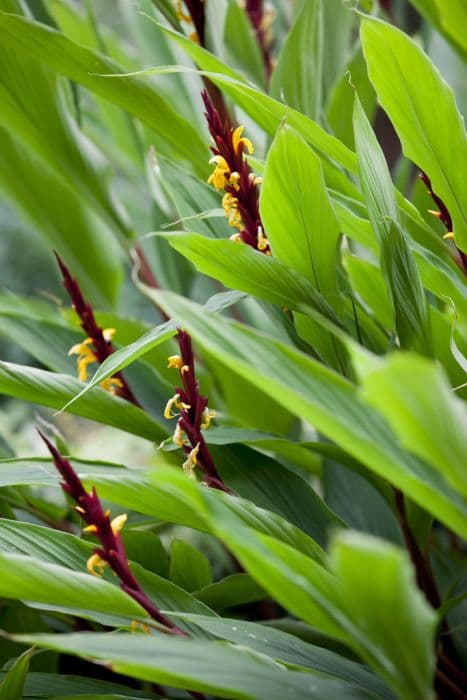Sorung Ginger Lily Hedychium densiflorum 'Sorung'

ABOUT
Hedychium densiflorum 'Sorung', commonly known as the dense ginger lily, is a striking plant with lush, glossy green foliage. Its leaves are lance-shaped, and they grow in an alternate pattern along the stems, giving the plant a robust and dense appearance. One of the most distinctive features of this ginger lily is its inflorescence, which consists of cone-shaped clusters of flowers. The blossoms are often a vibrant hue, which can range from a bright yellow to a warm orange, emitting a delightful and sometimes intense fragrance that can attract pollinators like butterflies and hummingbirds. The flowers are typically arranged in a dense, spiral pattern around the inflorescence, contributing to the plant's ornamental appeal. After blooming, the flowers give way to seed capsules that may also be of interest in the garden. The dense ginger lily presents a tropical aesthetic that can bring a sense of exotic vibrance to any setting in which it is placed.
About this plant
 Names
NamesFamily
Zingiberaceae
Synonyms
Sorung Ginger, Dense-Flowering Ginger, Hardy Ginger Lily, Orange Bottlebrush Ginger
Common names
Hedychium densiflorum 'Assam Orange'
 Toxicity
ToxicityTo humans
The Hedychium densiflorum 'Sorung', commonly known as ginger lily, is not widely recognized as a poisonous plant and there's limited information on its toxicity to humans. It is primarily grown for ornamental purposes and typically does not cause harm when touched or ingested in small quantities. However, it is always recommended to exercise caution and avoid eating ornamental plants as a general safety measure, as individual reactions can vary. If there is any concern or if any symptoms develop after ingestion, it is advisable to seek medical attention.
To pets
The toxicity of Hedychium densiflorum 'Sorung', commonly referred to as ginger lily, to pets such as dogs and cats is not well-documented. It is commonly grown for decorative purposes and is not known to be particularly hazardous. However, as with any non-food plant, consumption in large amounts could potentially cause digestive upset or other non-specific symptoms in some pets. To be on the safe side, keep pets away from this plant and if any adverse reaction is observed after they ingest parts of it, consult a veterinarian.
 Characteristics
CharacteristicsLife cycle
Perennials
Foliage type
Deciduous
Color of leaves
Green
Flower color
Orange
Height
4-6 feet (1.2-1.8 meters)
Spread
2-3 feet (0.6-0.9 meters)
Plant type
Herb
Hardiness zones
8
Native area
Himalayas
Benefits
 General Benefits
General Benefits- Ornamental Value: Adds a tropical flair to gardens with its lush foliage and attractive flowers.
- Low Maintenance: It does not require extensive care, which makes it suitable for gardeners of all skill levels.
- Attracts Pollinators: The flowers of the Himalayan Ginger attract bees, butterflies, and other beneficial pollinators to the garden.
- Hardiness: It can tolerate a range of soil conditions and is relatively hardy once established.
- Fast Growth: Himalayan Ginger can grow quickly, providing a rapid impact in landscape design.
- Drought Tolerance: Once established, it has a degree of drought tolerance, reducing the need for frequent watering.
 Medical Properties
Medical Properties- This plant is not used for medical purposes.
 Air-purifying Qualities
Air-purifying QualitiesThis plant is not specifically known for air purifying qualities.
 Other Uses
Other Uses- Insect repellant: The aromatic oils in Ginger Lily can deter certain insects when planted in gardens or when extracted oils are used.
- Companion planting: Ginger Lily can provide shade and a humid microclimate for shade-loving understory plants.
- Natural fencing: When planted in dense rows, Ginger Lily can form an attractive, tall, and dense barrier for privacy or as a windbreak.
- Handicraft materials: The sturdy stalks of Ginger Lily can be used in basket weaving or in creating natural crafts after drying.
- Perfumery: The fragrance of Ginger Lily flowers can be used for making natural perfumes or scented candles.
- Edible flowers: Although not commonly used, the flowers of the Ginger Lily might be ingested as a part of some traditional culinary practices.
- Garden aesthetics: With its striking flowers, Ginger Lily is often used for ornamental purposes to enhance the visual attraction of gardens and landscapes.
- Soil erosion control: The robust root system of Ginger Lily helps in stabilising soil and controlling erosion on slopes.
- Cultural symbolism: Ginger Lily may be used in cultural or religious ceremonies as a symbol of prosperity and fertility in certain cultures.
- Floral arrangements: Fresh or dried Ginger Lily flowers can be used in floral arrangements or as standalone bouquets due to their shape and color.
Interesting Facts
 Feng Shui
Feng ShuiThe Ginger Lily is not used in Feng Shui practice.
 Zodiac Sign Compitability
Zodiac Sign CompitabilityThe Ginger Lily is not used in astrology practice.
 Plant Symbolism
Plant Symbolism- Exoticism: The Hedychium densiflorum 'Sorung', more commonly known as Hardy Ginger Lily, is often associated with exoticism due to its tropical origins and lush, vibrant flowers.
- Sensuality: With its intoxicating fragrance and striking appearance, the Hardy Ginger Lily can symbolize sensuality and the allure of the unknown.
- Diversity: As a plant with various colors and forms, the Hardy Ginger Lily represents diversity and the beauty of varied forms in nature.
- Prosperity: In some cultures, the lush growth and vigorous nature of the Hardy Ginger Lily are seen as symbols of prosperity and abundance.
- Hospitality: The Hardy Ginger Lily's inviting scent and appearance can be symbolic of hospitality and the welcoming of guests.
 Water
WaterFor the Ginger Lily, the key is to keep the soil consistently moist during the growing season, typically watering once a week with about 2 gallons per mature plant. During hot and dry spells, watering frequency should increase, potentially watering twice a week. In winter, when the plant is dormant, reduce watering to once every few weeks or when the soil has dried out, as the plant requires significantly less moisture during this time. Always check the top inch of soil for dryness before watering to avoid over-watering, which can lead to root rot.
 Light
LightThe Ginger Lily thrives best in partial shade to full sun conditions, with dappled sunlight being ideal. It's recommended to place it where it can receive morning sun and afternoon shade to prevent the leaves from scorching. Avoid deep shade, as this will result in fewer blooms and a less vigorous plant. An eastern or southern exposure with some protection during the peak afternoon hours would provide the most beneficial light conditions.
 Temperature
TemperatureThe Ginger Lily prefers warm conditions and will thrive in temperatures between 60°F and 80°F. It should be protected from temperatures below 50°F, as cold can damage the plant. The ideal range to maintain is between 70°F and 75°F for optimum growth and flowering. The plant can survive brief dips in temperature but sustained cold will result in damage or death of the plant.
 Pruning
PruningPrune the Ginger Lily to remove dead or damaged stems and to promote healthy growth and better air circulation. Pruning is best done in late winter or early spring before new growth begins. Cut back the foliage to a few inches above ground level annually. Always use clean, sharp pruning tools to make precise cuts and prevent damage to the plant.
 Cleaning
CleaningAs needed
 Soil
SoilThe best soil mix for the Ginger Lily should be rich, well-draining, and have high organic matter content. The soil pH should range between 6.0 and 7.5. A mixture of peat, pine bark, and perlite or coarse sand is often recommended to achieve the proper drainage and fertility.
 Repotting
RepottingThe Ginger Lily should be repotted every 2-3 years, or when it becomes root-bound. The best time for repotting this plant is in the spring before the new growth starts.
 Humidity & Misting
Humidity & MistingThe Ginger Lily thrives in high humidity conditions, ideally around 60-80%. It benefits from regular misting or placement in a naturally humid environment like a bathroom or kitchen.
 Suitable locations
Suitable locationsIndoor
Provide bright, indirect light and high humidity.
Outdoor
Plant in partial shade, rich soil, and keep moist.
Hardiness zone
8-10 USDA.
 Life cycle
Life cycleHedychium densiflorum 'Sorung', commonly known as Hardy Ginger Lily, begins its life cycle as a rhizome underground, which sprouts in spring to produce lush, ornamental foliage. By mid to late summer, the plant blossoms, boasting dense spikes of fragrant flowers that range in color from yellow to orange. After the flowering period, the blooms give way to seed capsules if pollination occurs. As the cooler fall weather sets in, the aerial parts of the plant start to die back, retreating to the rhizome, which survives through winter in a period of dormancy. In environments with harsh winters, the rhizome benefits from mulching for protection. With the arrival of the next spring, the cycle repeats as new shoots emerge from the rhizome, continuing the growth cycle of the Hardy Ginger Lily.
 Propogation
PropogationPropogation time
Spring-Early Summer
The most popular method for propagating Hedychium densiflorum 'Sorung', commonly known as ginger lily, is by dividing the rhizomes. This process is optimally done in the spring as the plant emerges from dormancy and begins to show new growth. To propagate, carefully lift the entire plant out of the ground using a spade, ensuring to keep a good amount of soil around the roots to reduce shock. The rhizomes can then be gently separated by hand or cut with a clean, sharp knife ensuring each division has at least one growth bud. Once divided, the rhizomes should be replanted immediately at the same soil depth they were originally growing, typically about 2 to 4 inches (5-10 centimeters), and watered well to help establish the new plants. It's important to maintain consistent moisture without overwatering during the initial growth period after division.









